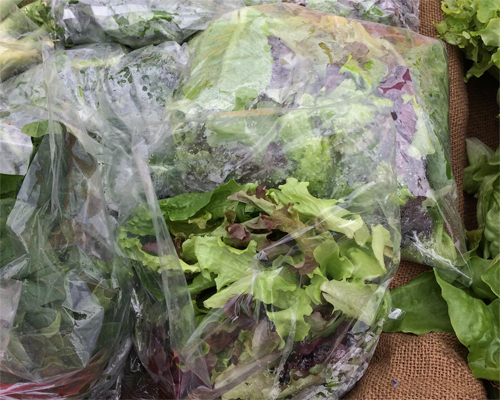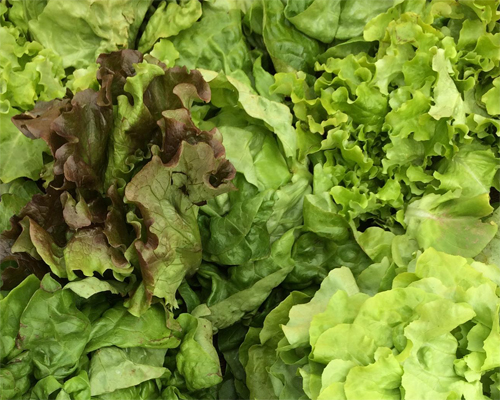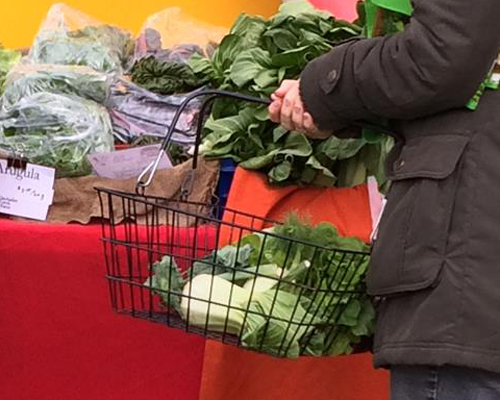
Fact Sheet FS1268
Ultra-Niche Crops are defined as exceptionally high-value crops that can provide a significant source of income to the farmer while using minimal land area.
High tunnel winter lettuce production offers a direct market sales advantage in providing freshly harvested, high-quality lettuce during the cooler months. Lettuce is known to be a fragile crop, susceptible to improper postharvest handling. The ability to shorten the length of time from harvest to sale increases the quality of the lettuce and the amount of time it is edible for the customer. Careful handling of lettuce from harvest to point of sale plays a critical role in the overall quality and safety of the lettuce.
Postharvest Quality and Handling
Should workers be trained on how to harvest winter lettuce?
Farm workers who harvest lettuce play a key role in the quality of the lettuce. Employees must be trained on how to properly harvest, pack, and transport the lettuce. An employee who is uneducated or unhappy with their work can have a negative impact on the product, customer satisfaction, and your sales revenue.
How often should the winter lettuce be harvested?
Timing of harvests should coincide with maturity of the lettuce variety and your sales opportunities. Sales dates and storage conditions are the main factors in determining harvest dates. Lettuce can be harvested prior to full maturity and sold as "baby" lettuce.
Will the lettuce flavor improve after it has been harvested?
Lettuce flavor will not improve postharvest. Both flavor and visual appearance can deteriorate due to improper handling. Browning on the cut end of lettuce, particularly head lettuce types, is something that cannot be avoided or changed. Pinking of the leaves is an indication of damage, and can be avoided through careful handling and proper packing.
What temperature should lettuce be stored at?
The optimal storage temperature for lettuce is 32°F. On sunny days the high tunnel temperatures will be elevated, and it is important to get harvested lettuce into cool temperatures as soon as possible. Harvested lettuce respiration rates increase with the surrounding temperature, particularly in younger leaves. Ideally lettuce should be in a cooling environment within an hour from harvest.
Once in the cooler the lettuce bins may be stacked, but no more than two high to allow for air circulation. Lettuce held at 32°F can be stored for up to four weeks, lettuce held at 41°F will have a reduced storage life of three weeks. Storage temperatures below 32°F will lead to freezing. An indication of freeze damage is a bronzing, which appears when the outer cuticle of the leaf separates from the leaf tissue.
What relative humidity should lettuce be kept at in the cooler?
The ideal relative humidity for lettuce storage is between 90 and 95%. Coolers with multiple crops stored in them tend to have higher relative humidity. If lettuce will be the only crop stored in the cooler, additional efforts may need to be made to raise the relative humidity. Covering the lettuce with a non-sealed covering or wetting the floor are options of increasing the relative humidity in a cooler.
How should lettuce be handled when transported to a sales location?
Lettuce should be fully cooled before it is transported for sale. Lettuce should be carefully loaded and stacked so that the leaves do not become damaged by crushing or bouncing of the vehicle.
When selling at a farm stand or market how should lettuce be stored? Lettuce is a crop that benefits from misting while on display. Water used for misting should meet drinking water standards. Maintaining a temperature as close to 32°F as possible and a higher relative humidity will increase the postharvest life of the lettuce. At outdoor markets where the temperature is below 32°F care should be taken to prevent the lettuce from freezing. Portable insulated coolers are an option to prevent freezing and increase relative humidity.
Food Safety Considerations
Do I have to worry about food safety issues with lettuce?
Lettuce is consumed without cooking and has been associated with human illness outbreaks in the past. Lettuce has an elevated risk of contamination from human pathogens due to growing close to the ground; the use of plastic mulch to reduce soil contact can help reduce this risk. Consideration should be given to the risk for contamination of lettuce within your production system through the development of risk assessments.
Risk assessments are a detailed evaluation of specific areas and practices on the farm. Consideration should be given to: identification of potential hazards, documentation of existing risk reduction measures, consideration of the chance and severity of potential harm, documentation of changes made to reduce risk, and annual monitoring of potential hazard points.
Each farm operation is unique, and the food safety considerations must be specific to the location, employees, field operations, and postharvest operations of a farm. Creating standard operating procedures (SOPs) for the reduction of identified risks is an important food safety tool.
Are there water quality standards specific to irrigation for lettuce? Contaminated irrigation water that comes in contact with lettuce can cause contamination. Ideally, for both plant disease and human disease, irrigation of lettuce should be done through drip tape. Contaminated overhead irrigation water can spread both plant and human diseases throughout a crop. The surfaces of lettuce leaves, and the cut end of the leaf, are difficult to sanitize once contaminated. Irrigation water should be tested to better understand its overall quality and how it is impacted by weather events. This is particularly true for surface irrigation water, such as ponds and streams.
Can I use compost with animal manures in lettuce production? Animal manures can carry human diseases in them, such as E. coli, Listeria and Salmonella. It is important that composts using animal manures as an ingredient are composted appropriately before they are applied to production areas fields. A minimum of 120 days between raw manure applications to soils is required prior to planting of lettuce. Currently the National Organic Program Standards are accepted practices by USDA and the FDA.
What should I do if I find that wildlife has entered the lettuce growing area? Developing an action plan to be used when fecal material or wildlife feeding on crops occurs is important. It is recommended that fields are scouted for animal activity prior to harvesting and that any areas where fecal material of feeding are found are taped off so that harvesting does not take place there. A five-foot buffer around fecal material is recommended. Once this plan is developed, all workers should be aware of it so that proper action is taken when they see a potential contaminant from wildlife.
Can farm workers contaminate lettuce? Lettuce is commonly harvested by hand, and the health of the harvester is critical. Workers coming in contact with produce and its growing area should receive annual training on human health and hygiene specific to fresh produce safety. This annual training should focus on human diseases communicable to others, the routes of contamination, proper handwashing, proper restroom use, and food safety policies specific to the farm. More information on this type of training can be found in the Rutgers Cooperative Extension fact sheet FS1230, "Worker Health and Hygiene".
Can I reuse sales containers? Packing materials can serve as a source of contamination if they are not handled and stored properly. Re-using containers is possible, but only if you know that they are not contaminated prior to use. Sanitizing in accordance with a food-grade sanitizer's label directions is acceptable, or use a single-use liner. Appropriate storage areas for containers must have a rodent control program, be free from other wildlife and pets, and be free of physical contaminants.
Critical Considerations
- Temperature management is the most critical aspect of prolonging postharvest quality for lettuce. Harvested lettuce should be removed from sun and heat as soon as possible.
- Attend an on-farm food safety training to better understand food safety risks and modes of contamination.
- Conduct risk assessments for your operation focusing on: land use history, water system and movement, animal activity (wildlife and domestic), soil amendments used and made, packing area and activities, and produce distribution methods.
- Develop written instructions (standard operating procedures or SOPs) for activities deemed high risk, such as procedures for washing produce or product contact surfaces. These SOPs will streamline processes at the farm and ultimately reduce the risk of product contamination.
- Train workers annually on worker personal health and hygiene and the identified risks on the farm.
- Sample irrigation and postharvest water as deemed necessary for generic E. coli. General guidelines are once a year for well water sources and three times a year (at first use, just prior to first harvest, and at peak use) for surface water sources. Third Party Audits (required by some wholesale buyers) and the Food Safety Modernization Act Produce Rule have specific testing requirements.
Resources
April 2017
Copyright © 2024 Rutgers, The State University of New Jersey. All rights reserved.
For more information: njaes.rutgers.edu.
Cooperating Agencies: Rutgers, The State University of New Jersey, U.S. Department of Agriculture, and Boards of County Commissioners. Rutgers Cooperative Extension, a unit of the Rutgers New Jersey Agricultural Experiment Station, is an equal opportunity program provider and employer.




 Project sponsored by the USDA-NIFA Beginner Farmer and Rancher Development Program.
Project sponsored by the USDA-NIFA Beginner Farmer and Rancher Development Program.